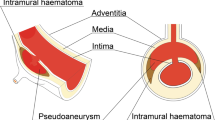Abstract
Two cases of carotid artery rupture due to postoperative infection were treated successfully with an emergency endovascular technique. A detachable balloon was attached to a 2 Fr microcatheter and was introduced through a 9 Fr guiding catheter. The balloons were detached at the rupture site and just proximal to the lesion. This technique has several advantages over surgical procedures.
Similar content being viewed by others

References
Ketcham AS, Hoye RC (1965) Spontaneous carotid artery hemorrage after head and neck surgery. Am J Surg 110:649–655
Martinez SA, Oller DW, Gee W, deFries HO (1975) Elective carotid artery resection. Arch Otolaryngol 101:744–747
Heller KS, Strong EW (1979) Carotid arterial hemorrhage after radical head and neck surgery. Am J Surg 138:607–610
Razack MS, Sako K (1982) Carotid artery hemorrhage and ligation in head and neck cancer. J Surg Oncol 19:189–192
Maves MD, Bruns MD, Keenan MJ (1992) Carotid artery resection for head and neck cancer. Ann Otol Rhinol Laryngol 101:778–781
Heller KS, Strong EW (1979) Carotid arterial hemorrhage after radical head and neck surgery. Am J Surg 138:607–610
Erba SM, Horton JA, Latchaw RE, Yonas H, Sekhar L, Schramm V, Pentheny S (1988) Balloon test occlusion of the internal carotid artery with stable xenon/CT cerebral blood imaging. AJNR 9:533–538
Blume WT, Ferguson GG, McNeill DK (1986) Significance of EEG changes at carotid endarterectomy. Stroke 17:891–897
Moody EB, Dawson RC, Sandler MP (1991)99mTc-HMPAO SPECT imaging in interventional neuroradiology: Validation of balloon test occlusion. AJNR 12:1043–1044
Gonzalez CF, Moret J (1990) Balloon occlusion of the carotid artery prior to surgery for neck tumors. AJNR 11:649–652
Halbach VV, Higashida RT, Hieshima GB, Dowd CF, Barnwell SL, Edwards MS, Melicharek M (1990) Aneurysms of the petrous portion of the internal carotid artery: Results of treatment with endovascular or surgical occlusion. AJNR 11:253–257
Han MH, Sung MW, Chang KH, Min YG, Han DH, Han MC (1994) Traumatic pseudoaneurysm of the intracavernous ICA presenting with massive epistaxis: Imaging diagnosis and endovascular treatment. Laryngoscope 104:370–377
Parodi JC, Palmaz JC, Barone HD (1991) Transfemoral intraluminal graft implantation for abdominal aortic aneurysm. Ann Vasc Surg 5:491–499
May J, White G, Waugh R, Yu W, Harris J (1993) Transluminal placement of a prosthetic graft-stent device for treatment of subclavian artery aneurysm. J Vasc Surg 18:1056–1059
Author information
Authors and Affiliations
Rights and permissions
About this article
Cite this article
Hirai, T., Korogi, Y., Sakamoto, Y. et al. Emergency balloon embolization for cartid artery rupture secondary to postoperative infection. Cardiovasc Intervent Radiol 19, 50–52 (1996). https://doi.org/10.1007/BF02560149
Issue Date:
DOI: https://doi.org/10.1007/BF02560149



